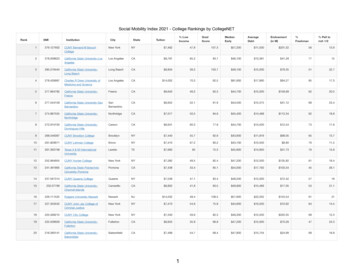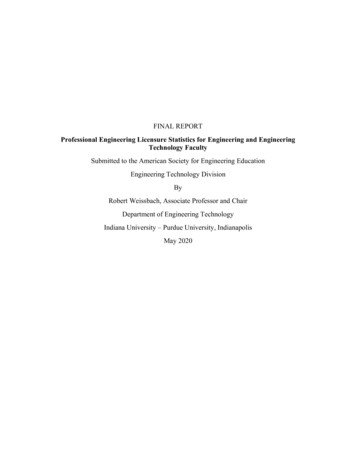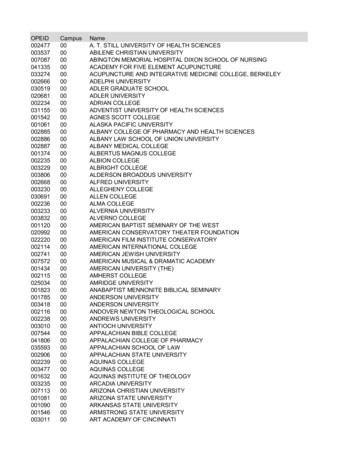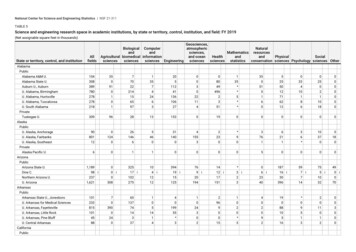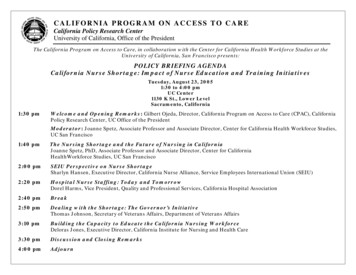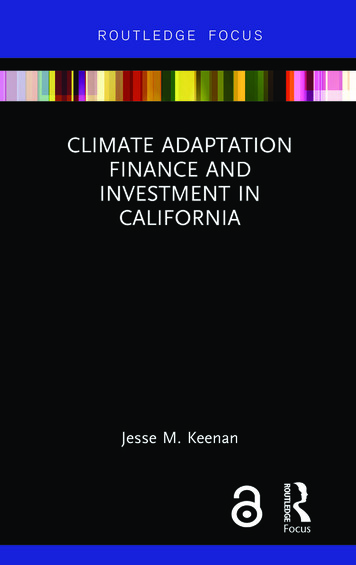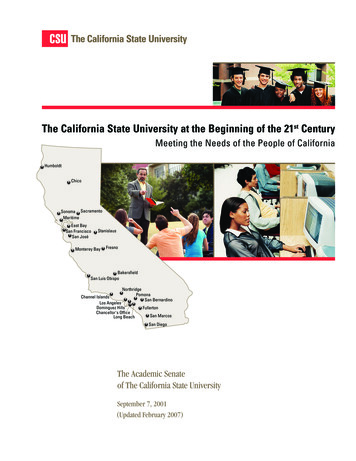
Transcription
The California State University at the Beginning of the 21st CenturyMeeting the Needs of the People of CaliforniaHumboldtChicoSonoma SacramentoMaritimeEast BaySan FranciscoSan JoséStanislausMonterey BayFresnoBakersfieldSan Luis ObispoNorthridgePomonaSan BernardinoChannel IslandsLos AngelesDominguez HillsChancellor's OfficeLong BeachFullertonSan MarcosSan DiegoThe Academic Senateof The California State UniversitySeptember 7, 2001(Updated February 2007)
“Our challenge right now is to find new ways to. . . preserve andimprove access as well as quality. . . We need to think creatively,or think ‘outside the box,’ about how we can meet the challengeof maintaining access and quality. That’s a tall order.”Chancellor Charles ReedNovember 3, 1999
ACADEMIC SENATEOFTHE CALIFORNIA STATE UNIVERSITY401 Golden Shore, Suite 139562-951-4010/4015Long Beach, Californiaemail: dhennessy@calstate.edu90802-4210FAX 562-951-4911Jacquelyn Ann K. Kegley, ChairNovember 13, 2001Members of Joint Committee to Develop a Master Planfor Education-Kindergarten through UniversityMembers of the California LegislatureTrustees of the California State UniversityMembers of the California State University Academic CommunityOn behalf of the Academic Senate of the California State University, I am presenting you with this copyof The California State University at the Beginning of the 21st Century: Meeting the Needs of the Peopleof California, a report adopted by the Academic Senate CSU on September 7, 2001. This report presentsour recommendations for policy and funding goals for the coming decade.The report began in late spring 2000, when the Joint Committee to Develop a Master Plan for EducationKindergarten through University queried the Academic Senate about the future needs of the CSU.The report surveys teaching and learning in the California State University at a crucial juncture: when theCSU faces both greatly increased student demand and large numbers of faculty retirements and whenmany indicators of quality have failed to recover from the fiscal crisis of the early 1990s. The reportconcludes with policy and funding recommendations for restoring and enhancing quality in the CSU sothat it is well positioned to meet the needs of California. Some of these recommendations are new, butmost are drawn from previous statements by the Academic Senate or the CSU Trustees. Some of ourrecommendations for funding, for example, have been part of recent budget initiatives from the CSUTrustees.We now know that the arrival of large numbers of additional students and the departure of large numbersof faculty members through retirements are taking place as the state enters a significant economicdownturn. The unprecedented state surpluses of late 2000 are gone, replaced with prospects for deficits.As we face the possibility of significant fiscal constraints in the near future, it is all the more important toremember one of the central messages of this report: The CSU has not yet recovered from the budget cutsof the early 1990s.It was never our expectation that our recommendations for funding would be-or could be-immediatelyimplemented, even in a period of budget surplus. It has always been our hope, however, that our analysesof the state of the CSU will inform future budget planning and that our recommendations for both policyand funding will define goals for the coming decade. We look forward to working cooperatively andcollegially with the CSU faculty, administration, Trustees, and, as necessary, the legislature to developthese recommendations into concrete proposals that will permit the CSU not only to meet the challenges itnow faces but also to serve better the people of California.On behalf of the Academic Senate of the California State University,Jacquelyn Ann K. Kegley, Professor of Philosophy, CSU Bakersfield,Chair of the Academic Senate CSUi
TABLE OF CONTENTSLetter of TransmittaliTable of ContentsiiList of Tables and GraphsiiiExecutive SummaryivResolution by the Academic Senate CSUvi1. Introduction12. The Evolving Missions of Public Higher Education in California83. Challenges to Achieving the Highest Levels of Quality Students Teacher-Learner Contact Graduate Study Infrastructure Staff Faculty Relations Between and Among Systems: CSU and K-12 Education Relations Between and Among Systems: CSU, UC, and the Community Colleges134. Meeting the Needs of the People of California Enrollment Projections: Many More Students The Crisis of Physical Infrastructure The Crisis of Faculty Hiring: Many More Students and Many More Retirements Developing New Programs to Meet State Needs Funding Quality and Funding Growth455. Recommendations63References66Acknowledgments68ii
MEETING THE NEEDS OF THE PEOPLE OF CALIFORNIATABLES1. CSU Degrees Awarded by Discipline, 2004-0522. CSU Baccalaureate and Masters’ Degrees As a Total of Those Awarded in California,by Discipline, 2004, Ordered by Proportion Awarded43. FTES, T/tt Faculty, and Temporary Faculty, 1994-95 through 2004-05324. Separations and Hiring of t/tt Faculty Members, 1988-2005355. Ethnic Minority Status and Gender of CSU Faculty, 1984-85 through 2004-05396. Separations, Searches, and Hiring of t/tt Faculty Members, 1995-96 through 1999-05497. Degrees Granted, CSU and UC, 200562GRAPHS1. Proportionate Distribution of CSU FTE Students by Level of Instruction,AY 1987-88 through 2003-0452. Student-Faculty Ratios, CSU, 1964-65 through 2004-05183. Student-Faculty Ratios and Cost per FTES, CSU, 1985-86 to 2003-2004, in 2005 Dollars184. Print Periodical Subscriptions and Expenditures for Print Periodical Subscriptions, All CSULibraries, 1980-81 through 2004-05235. Library Staffing, 1980-81 through 2004-2005236. Changes in Number of Staff and FTES, 1983-84 through 2004-2005247. Changing Numbers of Tenured, Tenure-track, and Temporary Faculty,CSU, 1980-81 to 2004-2005318. Changing Numbers of T/tt and Temporary Faculty, and Enrollments,CSU, 1980-81 to 2004-2005319. New Student Enrollment in CSU by Source, Fall Semesters, 1980-20044310. Community College Enrollments, Degrees, Certificates, and Transfers, 1995 through 20054311. The Graying of the Faculty: Distribution of Full-time Faculty by Age,Fall Semesters, 1980-20044812. CPEC Parity Figures and Actual CSU Salary Increases, 1986-87 through 2006-075013. Average Salary of Full-time Faculty, in Current and Constant Dollars, 1986-20045214. Average Salary, Assistant Professors, in Current and Constant (2003) Dollars, 1986-20045215. Faculty Separations by Cause, 1980-81 through 2004-0553iii
THE CALIFORNIA STATE UNIVERSITY AT THE BEGINNING OF THE 21ST CENTURYEXECUTIVE SUMMARYBrief Overview of Report This report by the Academic Senate CSU began in response to aquery from the Joint Committee to Develop a Master Plan for Education-Kindergarten throughUniversity. The response evolved into this report, and many of theThe CSU faces acategories in the report derive from the committee's original letter.greatly increasedThe report surveys teaching and learning in the California Statedemand at the sameUniversity at a crucial juncture: the CSU currently faces a greatlytime that manyincreased demand at the same time that many indicators of qualityindicators of qualitythe student-faculty ratio, library acquisitions, staff availability, andhave failed to recovermore-have failed to recover from the fiscal crisis of the early 1990s.The report concludes with policy and funding recommendations forfrom the fiscal crisisrestoring and enhancing quality in the CSU so that it is wellof the early 1990s.positioned to meet the needs of California.1. Introduction The California State Colleges (later the California State University or CSU)became one of the state's three systems of higher education in 1960, when the legislatureapproved the Master Plan for California Higher Education (Donahoe Act), guaranteeingevery Californian the opportunity to attend college and differentiating the missions of threesegments. Today’s CSU, in its accessibility, its high standards for faculty retention andtenure, and its enhanced complexity of offerings and degree programs, has become animportant engine for California’s economy, providing thousands of graduates annually to theCalifornia workplace and to California’s educated citizenry, so vital to the future of ademocratic society.2. The Evolving Missions of Public Higher Education in California The changes in the CSUover the last 40 years reflect the greater public expectations generated by the new necessitiesof globalization and a technical or information-based economy. Just as the needs ofindividuals participating in California higher education have changed, so the Master Planitself has evolved and will continue to change as it remains responsive to the changesassociated with the state's requirements and opportunities. This section of the report surveysappropriate sections of the state education code.3. Challenges to Achieving the Highest Levels of Quality Funding cuts at the time ofCalifornia's fiscal crisis of the early 1990s continue to have a serious impact on the studentfaculty ratio, library collections and library staffing, the physical and technologicalinfrastructure, the clerical-secretarial and technical staff, and the faculty. Other parts of thissection examine issues of remediation and transfer from community colleges. The longestpart of this section reviews the faculty by elaborating on responses to queries from the JointLegislative Committee; it surveys the current types of faculty, their responsibilities, and thechanging ratio between tenured/tenure-track faculty and temporary faculty.4. Meeting the Needs of the People of California This section of the report begins with asummary of enrollment projections over the coming decade, then examines the ability of theCSU to meet the needs both of its projected enrollment and of the state more generally. Itexamines the crisis of physical infrastructure and, especially, the crisis of faculty hiring. Itthen explores some emerging needs for new programs and concludes with an examination ofcurrent approaches to state funding.iv
MEETING THE NEEDS OF THE PEOPLE OF CALIFORNIA5. Recommendations to Enable the CSU to Accomplish Its Missions More Effectively andThereby to Serve the People of California Better This section presents recommendations forchanges in code and in funding that proceed from the analysis in sections 3 and 4. In itsrecommendations, the Academic Senate CSU focuses on restoring and enhancing the qualityof education in the CSU. Improvements in K-12 that bring better prepared students to theCSU would have the support of the CSU faculty, but recommendations in that area arebeyond the scope of this report. These recommendations are not presented in any priorityorder.Recommendations Requiring Legislative Action:1. Provide to all CSU faculty members the opportunity to devote a minimum of one-fifth oftheir assigned workload to research, scholarship, and creative activity.2. Revise current budget formulae to restore and enhance the quality of education and toencourage new program development.3. Authorize and provide appropriate funding to CSU campuses to offer the Ed.D.Other Recommendations:1. Reduce the current student-faculty ratio to the level typical before the state's fiscal crisis ofthe early 1990s.2. Remedy insufficiencies due to delayed maintenance and delayed purchasing during the early1990s. Bring state-of-the-art technology to more CSU classrooms.3. Augment CSU library collections and restore library staffing.4. Establish incentives to attract new faculty members of the highest quality, includingimproved benefits, housing subsidies or subsidized housing, and moving expenses.5. Hire additional tenure-track faculty and improve funding for searches; reduce the currentproportion of lecturers by hiring more tenure-track faculty.6. Increase the number of secretarial/clerical staff and technical staff who provide services tostudents and faculty. Improve staff wages and benefits to attract and retain the best qualitystaff in these positions.7. In recognition that research, scholarship, and creative activity are required for effectiveteaching, increase support for all CSU faculty members to engage in these activities;specifically, provide additional sabbaticals and other research support for CSU faculty andreconfigure the CSU faculty workload so that a one-fifth is devoted to faculty development(including research, scholarship, and creative activity). Reducing the teaching load to amaximum of three-fifths of the total workload and specifying that a minimum of one-fifth ofthe total workload be devoted to scholarly activity will bring CSU faculty more closely intoline with the faculty at comparable institutions and will attract new faculty of the highestquality.8. Adjust CSU faculty salaries to achieve parity with comparison institutions to remaincompetitive with other academic institutions.9. Improve the current CSU physical plant to provide adequate facilities for existing programsand for growth.A brief list of references follows the final section.v
THE CALIFORNIA STATE UNIVERSITY AT THE BEGINNING OF THE 21ST CENTURYACADEMIC SENATEOFTHE CALIFORNIA STATE UNIVERSITYAS-2547-01/ EXSeptember 7, 2001The California State University at the Beginning of the 21st Century:Meeting the Needs of the People of CaliforniaRESOLVED: That the Academic Senate of the California State University adopt the report, TheCalifornia State University at the Beginning of the 21st Century: Meeting theNeeds of the People of CaliforniaRESOLVED: That the Academic Senate CSU provide copies of this report to members of theBoard of Trustees, campus presidents and provosts, and members of thelegislature, along with campus senate chairs; and be it furtherRESOLVED: That the Academic Senate CSU thank the campuses for their invaluable adviceduring the preparation of this report.RATIONALE: During the 2000-2001 academic year, the Academic Affairscommittee of the Academic Senate CSU prepared the initial draft of the attachedreport. Campuses were asked for their advice at several steps of the draftingprocess, and they responded with many valuable suggestions. During Spring2001, an ad hoc drafting committee revised and refined the draft in the light ofadvice from campuses. The purpose of the report is to present the concerns of theAcademic Senate CSU to policy-making bodies, the Board of Trustees and thelegislature, who are responsible for policy-making and budget-making for theCSU.Approved Unanimously - September 7, 2001vi
1. INTRODUCTIONBackground: The History of the CSU The CSU, in the form of the California State Colleges,was created by the California Master Plan for Higher Education (the Donahoe Act, 1960). Thatact has been praised as an ingenious policy that has been responsible for many of the successesof higher education in California since 1960. While the Master Plan provided a guideline forassigning responsibilities and allocating funds among the state's three systems of highereducation, the successes of higher education in California in the three decades following WorldWar II may owe more to the willingness of the California legislature and voters to infuse largeamounts of capital into higher education–in the form of more than a dozen new campuses, scoresof new buildings on existing campuses, and the hiring of thousands of new faculty members tostaff these new and expanded institutions–than to the Master Plan itself. These investments inthe infrastructure of higher education–together with similar investments in the state'sinfrastructure for transportation and water resources–stand among the most important elementsin the spectacular economic growth and development of California during the decades followingWorld War II. Two recent books, John Aubrey Douglass's The California Idea and AmericanHigher Education: 1850 to the 1960 Master Plan (2000) and Nicholas Lemann's The Big Test:The Secret History of the American Meritocracy (1999), have surveyed the creation of theMaster Plan. Both have stressed the extent to which the Master Plan represented an effort by theUniversity of California to restrict the growth and evolution of the state colleges as a way ofprotecting its own funding base. Lemann bluntly describes the Master Plan as "naked in itssurgical disabling of the state colleges' ambitions". 1Despite such "surgical disabling" at the time the Master Plan was developed, the CSU todaybears little resemblance to its predecessor in 1960. In 1960, the state colleges that made up thecore of what was then called the California State Colleges were but a generation removed frombeing the state's teachers' colleges, the direct descendents of the normal schools created in the19th century to train teachers for grades 1-8. In the early 1920s, the normal schools becameteachers' colleges; in the 1930s they became state colleges. Their basic mission changedsignificantly after World War II, as both the state's population and the number of its collegestudents surged, and then surged again in the 1960s and 1970s.To meet the changing needs of its students and the state, the CSU added new degree programs,developed a large post-baccalaureate program, expanded the breadth and depth of its courseofferings, and recruited and retained a faculty of high quality, nearly all of whom now haveearned the doctorate or the relevant terminal degree (here and throughout this report, the termfaculty, unless otherwise specified, includes teaching faculty, library faculty, and counselors).Many CSU faculty members have achieved distinction in their profession both through teachingand through scholarship, the creation of new knowledge, and creative activity. The CSU grew tobecome the largest system of higher education in the nation, as its enrollments grew from 70,142in Fall 1960 to 368,469 in Fall 2000. At the same time, the Master Plan itself evolved (as will beseen in the next section of this report). By 1987, the Commission for the Review of the MasterPlan for Higher Education could announce that the "CSU is a very different institution than it1John Aubrey Douglass, The California Idea and American Higher Education: 1850 to the 1960 Master Plan (Stanford:Stanford University Press, 2000), chs. 9-11 and Epilogue, esp. pp. 248, 252, 267, 316; Nicholas Lemann, The Big Test: TheSecret History of the American Meritocracy (New York: Farrar, Straus and Giroux, 1999), ch. 11, esp. pp. 132, 134.1
THE CALIFORNIA STATE UNIVERSITY AT THE BEGINNING OF THE 21ST CENTURYwas when the 1960 Master Plan was written. It offers undergraduate and graduate courses ofgreat breadth and depth". 2The CSU Today The CSU does, indeed, offer undergraduate and graduate programs of greatbreadth and depth. Preparation of teachers remains an important part of the CSU's currentprofile as indicated by the number of majors in Liberal Studies (the typical major taken bystudents preparing for a multiple subjects credential, for elementary teaching), in English (atypical preparation for the single subject credential in English), and in Social Sciences andHistory (the typical preparation for the single subject credential in Social Studies). The CSUalso prepares large numbers of graduates for a wide variety of other fields: architecture, libraryscience, business, nursing, computer science, theater, criminal justice, dietetics, agriculture, andmany more. Table 1 indicates current patterns of instruction in the CSU by discipline and level.Table 1. CSU Degrees Awarded, by Discipline, 2004-05BaccalaureateDisciplinesBusiness and ManagementInterdisciplinary StudiesSocial SciencesPsychology3EducationLettersPublic Affairs and ServicesCommunicationsFine and Applied ArtsEngineeringHealth Professions (including Nursing)Computer and Info SciencesBiological SciencesAgriculture and Natural ResourcesHome EconomicsForeign LanguagesMathematicsPhysical SciencesArchitecture and Environmental DesignArea StudiesLibrary 624651516422100Percent ofall 7Joint DoctoratePercentof 0.2%1.8%100.0%NumberPercent ofall 3.2%53100.0%SOURCE: CSU Statistical Abstracts, 1999-2000. Updated, 8-05, CSU Statistical Abstract to July 2004, Table 145.Updated, 1/07, CSU Statistical Abstract to July 2005, Table 145.23Commission for the Review of the Master Plan for Higher Education, The Master Plan Renewed: Unity, Equity, Quality, andEfficiency in California Postsecondary Education (Sacramento, 1987), p. 10.There are no undergraduate degree programs for K-12 teachers in the CSU. Those listed as baccalaureate degrees in educationin the CSU Statistical Abstracts and in the CPEC reports (Tables 2 and 8) include a wide range of programs, from Aviation toGraphic Communications; within this category, Child Development/Early Childhood Education and Kinesiology/PhysicalEducation account for the large majority of graduates.2
MEETING THE NEEDS OF THE PEOPLE OF CALIFORNIAThe CSU awards nearly half of all baccalaureate degrees in California and nearly two-thirds ofall baccalaureate degrees from public institutions; the CSU awards more than a third of allmasters’ degrees in California and more than two-thirds of the masters’ degrees from publicinstitutions. In several fields, the CSU produces the majority of all degrees in the state, andsometimes the very large majority, as can be seen in Table 2.The Academic Senate CSU began a re-examination of baccalaureate education within the CSUin the fall of 1995. Study of this issue proceeded throughout the 1995-96 and 1996-97 academicyears, ultimately involving the academic senates on each campus and a large conference of CSUfaculty from throughout the system. The Academic Senate CSU adopted the final statement,Baccalaureate Education in the California State University, in November 1997. This statementbest represents the current views of the CSU faculty on undergraduate education in the CSU. Inthis statement, the Academic Senate CSU identifies the following purposes of the baccalaureate:CSU undergraduate education engages each student in the development ofadvanced knowledge, skills, and understanding that are the mark of educatedpersons. Such an education is necessary for lifelong intellectual endeavor, forbecoming productive members of society, and for participating in democraticinstitutions and civil society. Equally important, the baccalaureate providesopportunities to understand values and ethics and the role they play in the life ofthe individual and of society.Higher education, besides providing society with "educated persons", remains themost effective agent for individual fulfillment and advancement, thus stimulatingbroad social change. A public university system is mindful of its roles in societyand of its need to offer the opportunity and benefits of higher education on a fairbasis to all who qualify.3
THE CALIFORNIA STATE UNIVERSITY AT THE BEGINNING OF THE 21ST CENTURYTable 2. CSU Baccalaureate and Masters' Degrees as a Total of Those Awarded in California, By Discipline,2004, Ordered by Proportion AwardedBaccalaureateDisciplineTransportation and Materials MovingWorkersSecurity and Protective ServicesEducationLiberal Arts, General Studies,HumanitiesHuman Services, GeneralParks, Recreation, Fitness, LeisureStudies, Natural ResourcesHealth Professions and Related SciencesAgriculture, generalBusinessCommunicationsWork and Family StudiesEnglish Language and LiteraturePsychologyHistoryForeign Languages and LiteraturesEngineering and Related TechnologiesArchitecture and Related ProgramsVisual and Performing ArtsComputer and Info SciencesMathematics and StatisticsSocial SciencesPhysical SciencesArea, Ethnic, and Cultural StudiesBiological and Life SciencesPhilosophy, Religion, and TheologyMulti, Interdisciplinary StudiesLegal Studies, GeneralLibrary ScienceAll fields, 2004:MastersNumberin CSU95Numberin State100CSUTotal asPercentof 0.040.33.558.90.081.032.7Numberin CSUNumberin StateCSUTotal asPercentof StateTotalSOURCE: CPEC Student Profiles, 1999 www.cpec.ca.gov. Updated July, 2005, CPEC Student Profiles, 2003.Updated Jan. 2007, CPEC Student Profiles 2004.Thus, a student with a CSU baccalaureate, whether a graduate of a liberal arts program or aprofessional program, is prepared to contribute broadly to the economy, society, polity, andculture of California–prepared not just for a specific career and career changes but also for arange of contributions to civil society. Preparing graduates for "lifelong intellectual endeavor" isa primary purpose of the CSU, and a purpose that is more likely to be of lasting value to itsgraduates–and to the state–than narrowly focused vocational preparation.The CSU also offers a wide range of graduate and post-baccalaureate professional programs.Teacher credential programs prepare some 60% of the state's teachers, typically as postbaccalaureate students. Master of Arts programs in the liberal arts and sciences prepare studentsfor community college teaching, entry into Ph.D. programs, or a range of other careers. Master4
MEETING THE NEEDS OF THE PEOPLE OF CALIFORNIAof Business Administration programs prepare their graduates for careers in business. Master ofFine Arts programs, typically terminal degrees, prepare graduates for careers in, e.g., music, art,film, or teaching in those fields. Master of Social Work programs prepare social workers, andother post-baccalaureate programs exist in other professional areas. While CSU-UC jointdoctoral programs are relatively small in terms of the number of graduates, they nonethelessprovide important opportunities for students who might not otherwise be able to pursue adoctoral degree. The full list of post-baccalaureate programs is long and diverse, reflecting thevital role of both liberal arts and professional graduate programs in the economic life of the state.Still other programs, geared to the needs of particular professionals, are offered through extendededucation programs.Graph 1 presents recent patterns of CSU students by level, 4 and indicates how, over the pastdecade, both graduate and post-baccalaureate enrollment has increased somewhat in response tostudent demand, from 13.5% of the total in 1989-90 to 15.1% in 1999-2000. There is everyreason to anticipate that this pattern will continue as the state's economy continues to demand anever more sophisticated workforce.Graph 1. Proportionate Distribution of CSU FTE Studentsby Level of Instruction, AY 1987-88 through 2003-04100%Percent80%60%40%20%0%87- 88- 89- 90- 91- 92- 93- 94- 95- 96- 97- 98- 99- 00- '01- '02- '03- '0488 89 90 91 92 93 94 95 96 97 98 99 00 01 02 03 04 05LD Undergrad 29. 29. 29. 28. 28. 23. 23. 24. 25. 26. 27. 27. 27. 28. 29. 29 29 28UD Undergrad 56. 56. 57. 57. 59. 61. 62. 62. 60. 59. 58. 57. 56. 56. 55. 55 56 58Grad./Post-BA 13. 13. 13. 14. 14. 14. 13. 13. 13. 14. 14. 14. 15. 15. 15. 16 16 14No overall statistical profile can begin to capture the diversity of accomplishments by CSUfaculty and students. Nor can any list of examples provide more than an impressionistic account4Graph 1 is based on Table 149, CSU Statistical Abstracts.5
THE CALIFORNIA STATE UNIVERSITY AT THE BEGINNING OF THE 21ST CENTURYof some of those accomplishments. Nonetheless, the following list provides illustrations of whatit has meant to have been a part of the CSU over the past decade: 2001: Zeyad Elsayed, a student at CSU Sacramento, was one of six national recipients of theHoward R. Swearer Student Humanitarian Award. CSU Long Beach outfielder/1st basemanJeremy Reed earned one of 22 spots on the U.S. National baseball team. 2000: William J. Christmas, San Francisco State; Michael S. Eldridge, Humboldt State;Sabina Magliocco, CSU Northridge; and Christina Rivera-Garza, San Diego State, receivedhighly competitive National Endowment for the Humanities (NEH) fellowships for the 200102 academic year. 1999: Jennifer Booth, San Diego State, received a National Research Council fellowship. 1998: CSU Long Beach, CSU Los Angeles, and San José State were three of the nineuniversities nationwide to receive grants from the Society of Manufacturing Engineers(SME) Education Foundation’s Manufacturing Education Plan to develop industry-educationpartnerships. There were a total of 112 applicants. 1997: Solar Eagle III, from CSU Los Angeles, took first place in the national Sunrayce 97solar car competition. 1996: Carlos G. Gutierrez, professor of chemistry at CSU Los Angeles, was among the firstrecipients of the Presidential Award for Excellence in Science, Mathematics and EngineeringMentoring. 1995: Geoffrey Marcy, professor of physics and astronomy at San Francisco State, madeworldwide headlines with the first ever discovery of a planet orbiting another sun. CSUFullerton won its third College World Series. 1993: U.S. News & World Report recognized Cal Poly San Luis Obispo as the best publiccompre
1. Proportionate Distribution of CSU FTE Students by Level of Instruction, AY 1987-88 through 2003-04 5 2. Student-Faculty Ratios, CSU, 1964-65 through 2004-05 18 3. Student-Faculty Ratios and Cost per FTES, CSU, 1985-86 to 2003-2004, in 2005 Dollars 18 4. Print Periodical Subscriptions and Expenditures for Print Periodical Subscriptions, All CSU



